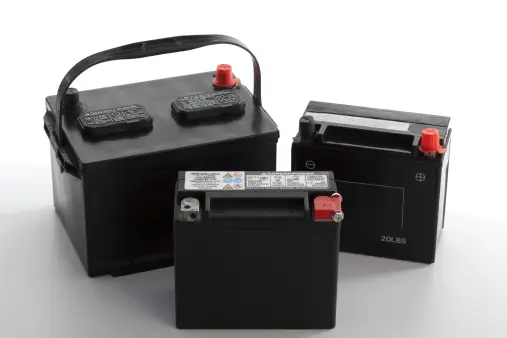August 11, 2023
What kind of battery is a car battery?
A car battery is typically a lead-acid battery. Lead-acid batteries are a type of rechargeable battery that uses a chemical reaction between lead dioxide (PbO2) and sponge lead (Pb) to generate electrical energy. These batteries are commonly used in vehicles because they can deliver a high amount of current for short bursts, which is necessary for starting the engine.
Lead-acid batteries consist of several cells connected in series, where each cell produces around 2 volts. A standard car battery usually has six cells, resulting in a nominal voltage of 12 volts.
It’s important to note that while lead-acid batteries are commonly used in cars, there is ongoing research and development in the field of automotive batteries. Electric vehicles, for example, often use lithium-ion batteries due to their higher energy density and efficiency compared to lead-acid batteries.

Is a car battery STD or AGM
Car batteries can come in two main types: Standard (or Flooded) Lead-Acid Batteries and Absorbent Glass Mat (AGM) Batteries.
- Standard (Flooded) Lead-Acid Batteries (STD): These are the traditional type of car batteries that have been used for many years. They contain liquid electrolyte that is free to move within the battery cells. These batteries require occasional maintenance, such as adding distilled water to replenish the electrolyte levels. They are generally more affordable but are more prone to leakage and require proper ventilation.
- Absorbent Glass Mat (AGM) Batteries: AGM batteries are a more advanced type of car battery. They use a special mat made of glass fibers to hold the electrolyte in place, which reduces the risk of leakage and makes them more resistant to vibrations and shocks. AGM batteries are maintenance-free, have a longer lifespan, and can deliver higher bursts of power compared to standard flooded batteries. They are commonly used in vehicles with advanced electrical systems, as well as in start-stop systems and hybrid vehicles.
The choice between STD and AGM depends on your vehicle’s requirements, your budget, and the features you value. AGM batteries are generally considered an upgrade due to their enhanced performance and reduced maintenance needs, but they can be more expensive than standard flooded batteries. Always refer to your vehicle’s manufacturer recommendations and consult with a professional if you’re unsure about which type of battery is best for your specific car model and usage.
What happens if you charge an AGM battery on STD?
Charging an AGM (Absorbent Glass Mat) battery using a charging mode or settings intended for STD (Standard or Flooded) batteries could potentially result in overcharging and damage to the AGM battery. This is because AGM batteries have different charging requirements compared to standard flooded batteries. AGM batteries are designed with a specific charge profile that optimizes their performance and lifespan.
AGM batteries have a lower internal resistance and can accept higher charging currents than flooded batteries. They also have a different charging voltage requirement to ensure proper charging without causing damage. Charging an AGM battery using settings meant for standard batteries could lead to overcharging, which can cause excessive heat generation, electrolyte loss, and even cell damage or failure.
It’s important to always follow the manufacturer’s recommendations and guidelines for charging the specific type of battery you have. Modern battery chargers often come with different charging modes for different battery types, including AGM, standard flooded, and sometimes even gel cell batteries. If you are unsure about the correct charging settings for your AGM battery, it’s best to consult the battery manufacturer or a professional who is knowledgeable about automotive batteries.
Do you need a special charger to charge AGM batteries?
Yes, it’s generally recommended to use a charger specifically designed for AGM (Absorbent Glass Mat) batteries when charging them. AGM batteries have different charging characteristics compared to standard flooded batteries, so using a charger designed for AGM batteries ensures that the battery is charged properly and safely.
AGM batteries require a charging profile that includes the following features:
- Voltage Regulation: AGM batteries need to be charged with a controlled and regulated voltage to prevent overcharging. The charger should have settings or algorithms that adjust the charging voltage based on the battery’s state of charge.
- Current Limiting: The charger should have the ability to limit the charging current as the battery approaches full charge. This prevents overcharging and excessive heat generation.
- Multi-Stage Charging: AGM batteries benefit from multi-stage charging, which includes bulk charging, absorption charging, and float charging. These stages ensure that the battery is charged efficiently and then maintained at an appropriate voltage level.
- Temperature Compensation: Some AGM battery chargers have temperature compensation features that adjust the charging voltage based on the ambient temperature. This helps prevent overcharging or undercharging in varying temperature conditions.
Using a charger designed for AGM batteries helps prolong their lifespan, prevents overcharging, and optimizes their performance. It’s worth investing in a quality AGM battery charger if you have AGM batteries in your vehicles or other applications. Always follow the manufacturer’s recommendations and guidelines for charging to ensure the safety and longevity of your batteries.
